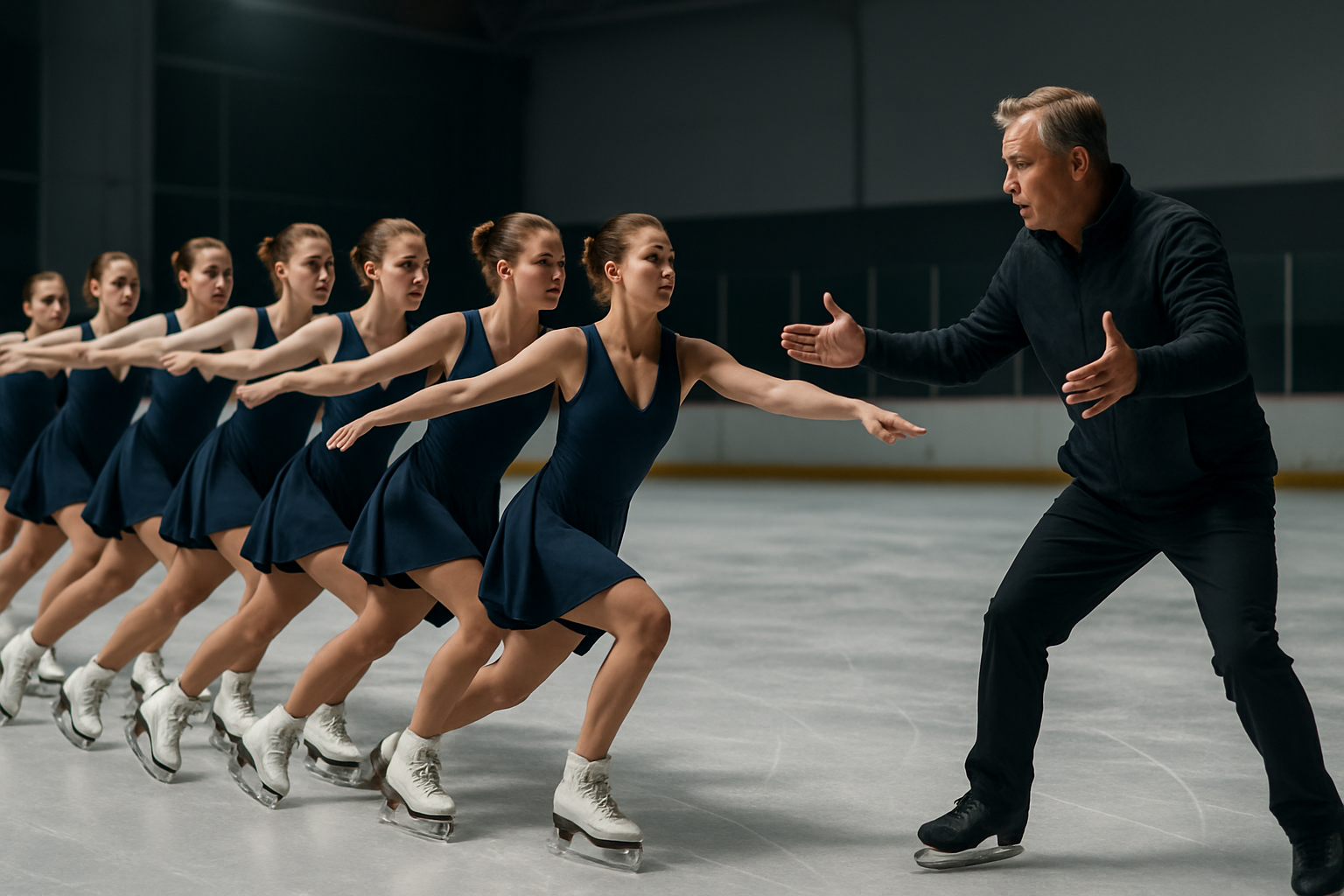Synchronized Skating: The Artistry of Team Precision on Ice
In the realm of winter sports, a captivating discipline has been gaining momentum, mesmerizing audiences with its blend of grace, synchronicity, and teamwork. Synchronized skating, often dubbed the "hidden gem" of figure skating, transforms the individual artistry of ice skating into a breathtaking display of collective harmony. As blades carve intricate patterns across the frozen canvas, teams of up to 16 skaters move as one, executing complex formations and rapid transitions that push the boundaries of human coordination.

Initially known as precision skating, the sport began with simple linear movements and basic formations. As it evolved, teams incorporated more intricate elements, such as wheels, blocks, and intersections. The discipline’s name was officially changed to synchronized skating in 1998, reflecting its emphasis on unity and coordinated movement.
Throughout the 1970s and 1980s, synchronized skating gained traction in North America and parts of Europe. The first official international competition was held in 1976 in Ann Arbor, marking a significant milestone in the sport’s recognition. As interest grew, national skating federations began to develop standardized rules and judging criteria, paving the way for more structured competitions.
The Choreographic Challenge
At the heart of synchronized skating lies the intricate choreography that defines each performance. Teams spend countless hours perfecting their routines, which typically last between four to five minutes. These programs are meticulously crafted to showcase a variety of elements, each demanding precise timing and flawless execution.
One of the most visually striking aspects of synchronized skating is the formation changes. Skaters seamlessly transition from one shape to another, creating kaleidoscopic patterns on the ice. Common formations include lines, circles, wheels, and blocks, each requiring skaters to maintain exact distances and alignments while moving at high speeds.
Intersections, where lines of skaters pass through each other, add an element of excitement and risk to performances. These maneuvers demand split-second timing and unwavering trust among team members. The difficulty is amplified by the fact that skaters must maintain their speed and position while avoiding collisions.
Lifts and pair elements, borrowed from pair skating and ice dancing, have been incorporated into synchronized skating routines in recent years. These additions have raised the bar for athleticism and creativity, allowing teams to showcase individual skills within the collective framework.
The Physical and Mental Demands
Synchronized skating presents unique challenges that set it apart from other figure skating disciplines. The sheer number of skaters on the ice requires an extraordinary level of spatial awareness and peripheral vision. Each team member must be acutely attuned to their teammates’ movements while executing their own steps and turns.
The physical demands of the sport are immense. Skaters must possess a combination of strength, flexibility, and endurance. Long practice sessions focus on building stamina and perfecting intricate footwork. The sport also requires a high degree of cardiovascular fitness, as skaters must maintain their energy and precision throughout the entire program.
Mental preparation is equally crucial in synchronized skating. The pressure to perform in perfect unison can be intense, and a single mistake by one skater can impact the entire team’s performance. Sports psychologists often work with teams to develop strategies for maintaining focus and composure under pressure.
Team dynamics play a vital role in the success of synchronized skating teams. Unlike individual figure skating events, synchronized skating relies on the collective effort of all team members. Coaches emphasize the importance of trust, communication, and mutual support among skaters. Team-building exercises and off-ice training sessions are often incorporated into practice regimens to strengthen these bonds.
Competition Structure and Judging
Synchronized skating competitions follow a structure similar to other figure skating events. Teams perform two programs: a short program and a free skate. The short program, typically around three minutes in length, includes required elements that must be executed in a specific order. The free skate, lasting about four and a half minutes, allows for more creative freedom while still adhering to technical requirements.
Judging in synchronized skating is based on the International Judging System (IJS) used in other figure skating disciplines. Performances are evaluated on both technical merit and program components. Technical elements are assigned base values, which are then adjusted based on the quality of execution. Program components assess aspects such as skating skills, transitions, performance, composition, and interpretation of the music.
The complexity of judging synchronized skating lies in evaluating the performance of up to 16 skaters simultaneously. Judges must consider not only the difficulty and execution of elements but also the uniformity and synchronization of the team as a whole. This multifaceted evaluation process requires a keen eye and extensive knowledge of the sport.
Global Growth and Olympic Aspirations
Over the past few decades, synchronized skating has experienced significant growth on the international stage. The International Skating Union (ISU) recognized it as an official discipline in 1994, leading to the establishment of the ISU World Synchronized Skating Championships in 2000. This annual event has become the pinnacle of the sport, attracting top teams from around the world.
The sport’s popularity has spread beyond its traditional strongholds in North America and Northern Europe. Countries such as Japan, Australia, and Russia have developed competitive programs, contributing to the global diversity of the discipline. International competitions now feature teams from over 20 countries, each bringing their unique style and cultural influences to the ice.
Despite its growing popularity, synchronized skating has yet to achieve Olympic status. The sport’s supporters have been actively campaigning for its inclusion in the Winter Olympics, arguing that it would bring a fresh and exciting element to the Games. The ISU has been working to meet the International Olympic Committee’s criteria for new sports, including increased global participation and gender equality.
The potential Olympic inclusion presents both opportunities and challenges for synchronized skating. While it would undoubtedly raise the sport’s profile and attract more resources, there are concerns about maintaining the essence of the discipline within the Olympic framework. The current team size of 16 skaters poses logistical challenges for Olympic organizers, leading to discussions about potential modifications to the sport’s format.
Training and Team Development
The path to becoming a competitive synchronized skater begins at a young age for many athletes. Junior teams often serve as feeder programs for senior-level squads, allowing young skaters to develop the necessary skills and team mentality. As skaters progress, they may move between teams or even relocate to train with top programs.
Training for synchronized skating is a year-round commitment. Off-season conditioning is crucial for maintaining fitness and developing strength. Dry-land training sessions focus on cardio, flexibility, and core strength. Many teams incorporate dance classes and ballet into their regimens to improve posture, line, and artistic expression.
On-ice practices are intense and highly structured. Teams typically spend several hours a day working on technical elements, program run-throughs, and fine-tuning choreography. Video analysis is a common tool used by coaches to identify areas for improvement and ensure precise synchronization.
The selection process for synchronized skating teams is highly competitive. Coaches look for skaters who not only possess strong individual skills but also demonstrate the ability to work effectively within a team. Factors such as height, skating style, and personality are considered to create a cohesive unit. Many top teams hold annual tryouts to fill open positions and maintain a high level of performance.
Music and Costume: The Artistic Elements
Music selection plays a crucial role in synchronized skating performances. Coaches and choreographers carefully choose pieces that complement the team’s strengths and allow for creative interpretation. The music must have a clear rhythm and structure to facilitate synchronization while also providing opportunities for artistic expression.
Recent years have seen a trend towards more diverse and contemporary music choices. Teams have performed to everything from classical symphonies to pop medleys and movie soundtracks. The challenge lies in selecting music that appeals to both judges and audiences while showcasing the team’s unique style.
Costumes in synchronized skating serve both aesthetic and functional purposes. They must be visually striking, enhancing the overall impact of the performance, while also allowing for freedom of movement. Designers work closely with teams to create costumes that complement the music and choreography while adhering to ISU regulations.
The visual impact of synchronized skating is amplified by the uniformity of the costumes. Identical outfits create a striking effect as the team moves in unison, blurring the lines between individual skaters and creating the illusion of a single, fluid entity on the ice. Attention to detail is paramount, with every sequin and trim carefully placed to ensure perfect symmetry across the team.
Technological Advancements in Training and Performance
As with many sports, technology has begun to play an increasingly significant role in synchronized skating. Advanced motion capture systems are being used to analyze skaters’ movements with unprecedented precision. This technology allows coaches to identify even the slightest discrepancies in timing or positioning, helping teams achieve a higher level of synchronization.
Wearable technology has also found its way into synchronized skating training. Sensors embedded in skates or clothing can provide real-time data on speed, acceleration, and body position. This information helps skaters fine-tune their performance and maintain consistency across the team.
In terms of performance analysis, high-speed cameras and sophisticated software are now standard tools for top teams. Coaches can review performances frame by frame, allowing for detailed feedback and targeted improvements. Some teams have even experimented with virtual reality simulations to help skaters visualize complex formations and transitions.
The use of technology extends to the ice itself. Advanced ice-making techniques and temperature control systems ensure optimal skating conditions. Some facilities have installed specialized lighting systems that can be synchronized with the music, adding another layer of visual spectacle to performances.
Challenges and Future Prospects
Despite its growth, synchronized skating faces several challenges as it seeks to expand its global reach. One of the primary obstacles is the cost associated with fielding a competitive team. The expenses of ice time, coaching, travel, and equipment for a large group of skaters can be prohibitive for many clubs and potential participants.
Another challenge lies in balancing the sport’s traditions with the need for innovation. As synchronized skating evolves, there is ongoing debate within the community about how to increase difficulty and spectator appeal without losing the fundamental aspects that define the discipline.
The quest for Olympic recognition remains a driving force in the sport’s development. Advocates argue that inclusion in the Winter Games would provide a significant boost to participation and funding. However, the process of gaining Olympic status is complex and requires navigating various political and logistical hurdles.
Looking to the future, synchronized skating appears poised for continued growth and evolution. The sport’s unique blend of athleticism, artistry, and teamwork offers a compelling spectacle that resonates with audiences worldwide. As more countries develop competitive programs and international competitions expand, synchronized skating is likely to attract increased media attention and sponsorship opportunities.
Efforts are underway to make the sport more accessible at the grassroots level. Many national federations are implementing development programs aimed at introducing synchronized skating to younger skaters and expanding participation in underrepresented regions.
Technological innovations are expected to play an increasingly important role in shaping the future of synchronized skating. From advanced training methods to enhanced spectator experiences, technology offers numerous avenues for the sport’s advancement.
The Unique Appeal of Synchronized Skating
What sets synchronized skating apart from other winter sports is its exceptional blend of individual skill and collective harmony. The sight of 16 skaters moving as one, executing complex maneuvers with precision and grace, creates a visual spectacle unlike any other on ice.
The sport appeals to a wide range of participants, from young skaters drawn to the team aspect to adult recreational teams who enjoy the camaraderie and fitness benefits. This inclusivity has contributed to the sport’s growing popularity and the development of various competitive levels.
For spectators, synchronized skating offers a unique viewing experience. The large-scale patterns and formations created by the teams provide a dynamic and ever-changing visual display. The sport combines the grace and artistry of figure skating with the excitement of rapid transitions and daring intersections.
Synchronized skating also embodies important values that resonate beyond the world of sports. The emphasis on teamwork, trust, and collective achievement serves as a powerful metaphor for cooperation and unity in broader contexts.
A Symphony on Ice
Synchronized skating represents a fascinating evolution in the world of ice sports. From its humble beginnings as a local pastime to its current status as a globally recognized discipline, the sport has continually pushed the boundaries of what is possible on ice.
As teams glide across the rink in perfect unison, they embody the pinnacle of collective human movement and coordination. Each performance is a testament to countless hours of practice, unwavering dedication, and the power of teamwork.
Whether synchronized skating ultimately achieves Olympic recognition or continues to thrive as a unique spectacle in its own right, its future appears bright. The sport’s ability to captivate audiences, challenge athletes, and foster a sense of community ensures its place as a cherished discipline in the world of figure skating.
As the blades carve intricate patterns and skaters weave through complex formations, synchronized skating continues to evolve, inspiring new generations of athletes and spectators alike. It stands as a beautiful reminder of what can be achieved when individual talents are harmonized into a collective masterpiece on ice.




